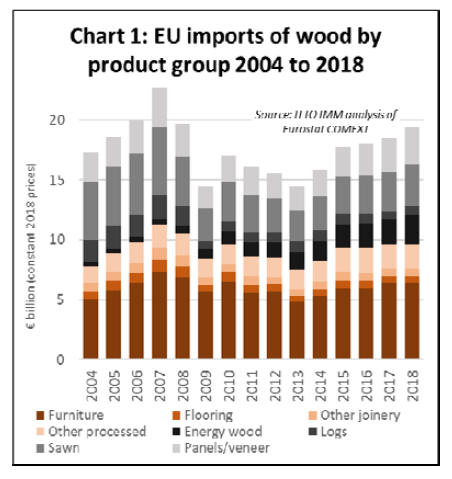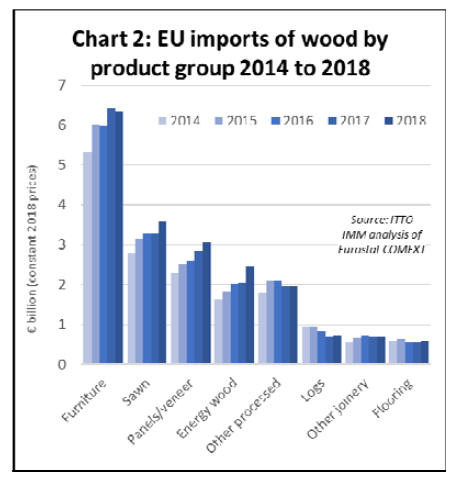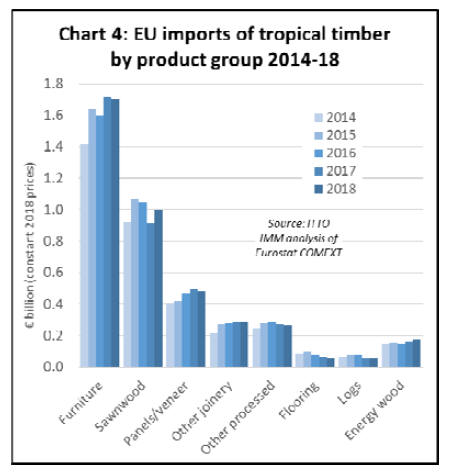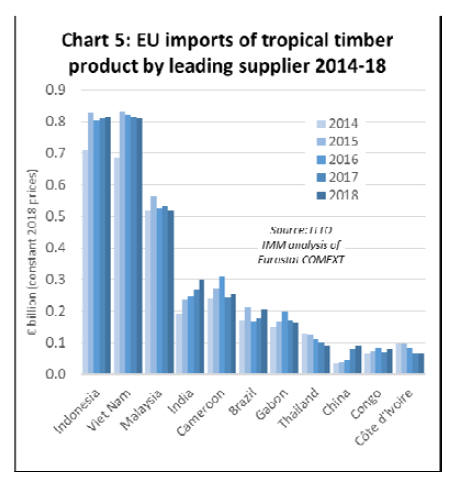|
Report from
Europe
Recovery in EU wood imports continues in 2018
The total value of EU imports of wood products was 19.44
billion euro in 2018, 5.1% more than in 2017. This
followed an increase of 2.4% to 18.49 billion euro in 2017.
In 2018 EU import value was at the highest level since
2008 just before the global financial crises (Chart 1).

The rise in imports into the EU occurred despite slowing
economic growth during 2018. According to the EU
Winter 2019 Economic Forecast published on 7 February,
economic activity in the EU moderated in the second half
of last year as global trade growth slowed, uncertainty
sapped confidence and output in some Member States was
adversely affected by temporary domestic factors,
including social tensions and uncertainty over fiscal policy
and Brexit.
As a result, GDP growth in both the euro area and the EU
likely slipped to 1.9% in 2018, down from 2.4% in 2017.
Slowing economic growth fed through into a fall in the
value of the euro and the British pound last year, both of
which weakened against the U.S. dollar by around 8%
during 2018. However, EU currencies remained strong
relative to currencies in several key Eastern European
supply countries, including Ukraine, Russia, and Turkey.
Both the euro and British pound strengthened by around
7% against the Russian rouble in 2018 and by over 25%
against the Turkish lira. These exchange rate fluctuations
generally favored EU imports from Eastern Europe and
acted as a drag on imports from North America and Asia.
Considering individual products (Chart 2), the value of EU
imports of wood furniture decreased by 1% to 6.35 billion
euro in 2018 after a 7% rise in 2017. A dip in EU imports
of wood furniture from China and Norway was offset by
rising imports from Ukraine, Belarus, Bosnia, Serbia,
Russia and Turkey.
This forms part of general trend of increasing EU
dependence on wood furniture manufactured in central and
Eastern Europe. EU wood furniture imports from tropical
countries, led by Vietnam, Indonesia and Malaysia, were
flat overall last year, although imports from India
continued to rise.

Growth in EU imports of sawn wood resumed in 2018
after flat-lining the previous year. The total value of EU
imports of sawnwood (including both softwood and
hardwood) in 2018 was 3.59 billion euro, nearly 10%
more than in 2017.
There was a particularly significant 21% increase in the
value of EU sawnwood imports from the CIS countries in
2018, building on an 11% increase the previous year. Most
of the increase in sawnwood imports from CIS countries in
2018 came from Ukraine, Belarus and Russia and is due
both to currency weakness and increasing controls on log
exports from these countries.
EU imports of sawnwood, both softwood and hardwood,
increased sharply from Brazil in 2018. Imports of tropical
sawn wood from both South East Asia (most notably from
Malaysia and Myanmar) and Africa (mainly Cameroon,
Gabon and Congo) regained some ground in 2018 after a
sharp fall the previous year. EU imports of sawnwood
from North America slowed a little in 2018.
EU imports of panels (mainly plywood) increased 8% to
Euro 3.06 billion in 2018. This follows a 9% rise in 2017
and is the fifth consecutive year of import growth of this
commodity.
As for other wood commodities, much of the gain was due
to a rise in plywood imports from Russia, Ukraine and
Belarus, however plywood imports from China, Brazil and
Indonesia also increased in 2018.
Imports of plywood and veneer from Gabon slowed in
2018, being affected by the financial problems of the
Rougier group. There was a partial recovery in veneer
imports from Cote d¡¯Ivoire in 2018. EU imports of
composite panels increased from Turkey.
The long-term rise in EU imports of energy wood
accelerated in 2018 with annual import value rising over
20% to 2.47 billion euro. This followed a slowdown to
only 3% growth in 2017 after average annual growth of
11% in the previous five years.
There was another sharp increase in EU imports of energy
wood from the United States in 2018 (now dominated by
pellets), to reach over 1 billion euro for the first time, with
most destined for the UK. Imports of energy wood also
increased sharply from Russia, Belarus and Ukraine,
mainly destined for continental EU. Import growth also
resumed from Brazil and Uruguay.
EU imports of other joinery products (mainly doors and
laminated wood for window frames and kitchen tops)
increased 1% to Euro 710 million in 2018, recovering
from a 1% fall the previous year.
Imports of joinery products from Russia, Ukraine and
Belarus continued to rise last year, with gains also made
by Indonesia, Vietnam, Bosnia, and Turkey.
China continued to lose ground, although it maintained its
position as the single largest external supplier of this
commodity group in the EU market, just ahead of
Indonesia. EU imports of joinery products were stable
from Malaysia in 2018.
After falling back 9% in 2016 and staying flat in 2017, EU
imports of wood flooring increased 2.6% to 580 million in
2018.
Flooring imports from China, by far the largest external
supplier accounting for around two thirds of the total,
recovered ground in 2018, while imports from Ukraine
increased sharply, helping to offset a decline in imports
from Indonesia, Malaysia, Brazil and Switzerland.
Pace of decline in EU tropical timber imports slows
The total value of EU imports of tropical timber products
(including direct imports and imports via third countries
such as China) increased 1.7% to 4.05 billion euro in
2018. This follows a 0.4% fall in import value in 2017.
The share of tropical timber in the total value of EU wood
product imports declined from 21.5% in 2017 to 20.8% in
2018. Although 2018 was the third straight year of
declining share for tropical timber, the rate of decline is
now much slower than in the decade prior to 2014 when
share fell continuously from around 36% to 22% (Chart
3).

China¡¯s share in total EU imports of timber products fell
from 29.4% in 2017 to 27.2% last year, the lowest level
since 2007. Meanwhile the share of Russia and other CIS
countries increased from 21.0% to 23.9%. In 2018, there
was a slight decrease in share of EU imports from non-EU
European countries (from 11.1% to 10.6%) and North
America (from 11.7% to 11.6%).
The slight increase in the total value of EU wood product
imports from the tropics in 2018 hides variations between
products groups (Chart 4). In 2018, there was a 9%
increase in EU imports of tropical sawn wood, from 914
million euro to 996 million euro, a rebound following the
13% decline the previous year.
There was also an increase in imports of energy wood
from tropical countries, rising from 160 million euro in
2017 to 179 million euro in 2018, with the biggest gains
comprising charcoal from Nigeria and other forms of
fuelwood from Congo and CAR.
The value of EU imports of other tropical products ¨C
including furniture, joinery, plywood, veneers, and logs -
were either flat or declining in 2018. The decline in
imports of tropical flooring was particularly dramatic,
down 15% to 59 million euro in 2018, following on from
an average decline of around 15% in each of the previous
three years.

The value of EU imports of all wood products from the
two leading tropical suppliers, Indonesia (813 million
euro) and Vietnam (812 million euro) was stable in 2018.
Total import value declined from Malaysia (by 5% to 519
million euro), Gabon (by 5% to 163 million euro) and
Thailand (by 13% to 90 million euro). (Chart 5)

However, these declines were offset by rising imports
from India (by 12% to 299 million euro, mainly furniture),
Brazil (by 16% to 205 million euro, mainly hardwood
sawnwood and decking), and China (by 15% to 89 million
euro, mainly tropical faced plywood). There was also
recovery in imports from some African countries, mainly
of sawn wood, including Cameroon, by 4% to 252 million
euro, and Congo, by 12% to 79 million euro.
Shifting destinations for EU timber imports
There are significant shifts on-going in destinations for EU
imports of timber products. After emerging as by the
largest single market in the EU for timber products from
outside the bloc between 2011 and 2015, the relative
importance of the UK eased a little in the 2016 to 2018
period.
The UK¡¯s share of total EU imports of timber products
from outside the region declined from a peak of 27.6% in
2015 to 25.0% in 2018. (Chart 6).

The UK¡¯s emergence as the leading EU market for
external timber suppliers between 2011 and 2015
coincided with relatively strong economic growth in the
country and rising consumer demand. This drove a strong
increase in imports from outside the EU, particularly wood
furniture and plywood from China, and wood furniture
from Vietnam.
There was also a big increase in UK imports of wood
pellets, mainly from the U.S., driven by the UK¡¯s climate
change commitments which encouraged some large
energy suppliers to switch from coal to biomass.
However, between 2016 and 2018, growth in the UK
economy slowed, particularly with rising uncertainty over
the effects of Brexit, currently scheduled for 29 March
2019 (but may be delayed for at least a few months,
although nobody yet knows for sure). The British pound
also weakened significantly on foreign exchange markets
during this period, dampening import growth.
Against this background, the fact that the Euro value of
UK imports from outside the EU remained flat at around
4.9 billion euro between 2016 and 2018 is a positive
outcome. During the same period, imports from outside
the EU by most other western European countries also
remained quite flat (Chart 7).
The Netherlands is an exception, experiencing strong
import growth, rising consistently from a low of 1.03
billion euro in 2013 to 1.42 billion euro last year on the
back of economic recovery and rising construction activity
in the country. The Netherlands is also playing a larger
role as a gateway for imports for distribution throughout
the EU.
In 2018, there was also a significant recovery in the value
of imports of timber products from outside the EU by two
countries that formerly were leading players in the global
timber trade but have since waned in significance; France
(up 8% to 1.62 billion euro), and Italy (up 8% to 1.17
billion euro).
In the case of France, imports increased sharply from
China (notably in furniture) in 2018, with gains also made
in imports from Vietnam (furniture), Brazil (hardwood
decking), and Russia (sawn softwood). For Italy, imports
in 2018 increased from Russia (mainly plywood), Ukraine
(mainly sawnwood), Bosnia (mainly energy wood), Brazil
(softwood plywood), Cameroon (sawnwood) and
Myanmar (sawnwood).

Rising share of EU timber imports destined for Eastern
Europe
While there was some increase in imports by a few
western European countries in 2018, eastern EU countries
recorded much larger and more consistent gains in imports
from non-EU countries last year. Large increases were
recorded in Poland, Romania, Lithuania, Latvia, Estonia,
Slovenia, Czech Republic, Croatia, Hungary, Bulgaria,
and Slovakia (Chart 8).

This is a reflection both of their proximity to Russia,
Ukraine and Belarus, the source of most of the rising
imports, relatively higher rates of economic growth and
construction sector growth in Eastern Europe, and the
establishment of new wood processing and manufacturing
capacity in the region.
EU wood products exports at record level in 2018
In 2018, the EU exported wood products with a total value
of 21.8 billion euro, 2% less than in 2017 when exports
were at record levels (Chart 9). EU exports of wood
furniture, flooring and other joinery products, and
plywood and other panels all slowed last year, a response
to general cooling in the global economy.
However, EU exports of logs and sawnwood continued to
increase in 2018 to record levels for these commodities,
exports of sawnwood up 2% to 5.54 billion euro and
exports of logs rising by over 14% to 735 million euro.

In 2018, the value of EU timber product exports continued
to rise to the USA but was flat or declining to the other
leading export markets including Switzerland, Norway,
China, Japan, Russia, Egypt and Algeria.
The combined effect of last year¡¯s fall in EU export value
and rise in EU import value was to reduce the EU¡¯s trade
surplus in timber products with the rest of the world from
3.70 billion euro in 2017 to 2.38 billion euro in 2018.
|